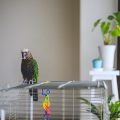Understanding House Rabbits in the UK
In recent years, an increasing number of Brits have embraced rabbits as beloved indoor companions, moving away from the traditional garden hutch. This shift reflects both a growing awareness of rabbit welfare and a desire for closer bonds with these affectionate pets. British homes, known for their varied architecture—ranging from cosy Victorian terraces to modern flats—present unique opportunities and challenges when it comes to keeping house rabbits safe and healthy. Unlike outdoor hutches, indoor environments offer protection from the UKs unpredictable weather and predators, but they also require thoughtful adaptation to prevent common hazards. Understanding the specific needs of pet rabbits within the context of British living spaces is essential for ensuring their wellbeing while maintaining harmony in your home.
Common Hazards in the British Home
When welcoming a rabbit into your home, it’s essential to recognise that British houses present unique hazards for these curious creatures. From traditional Victorian features to everyday electrical items and popular houseplants, many seemingly harmless aspects of our living spaces can pose risks to your bunny’s health and safety. Below, we highlight some of the most common dangers found in UK households and how you can identify them.
Electrical Appliances and Cables
British homes are often filled with electrical appliances—think kettles, toasters, TVs, and chargers. Rabbits have a natural instinct to gnaw, making exposed wires particularly tempting. Chewing on live cables not only damages your property but can cause serious harm or even prove fatal to your pet.
| Common Electricals | Associated Risks |
|---|---|
| Extension leads | Biting through wires, risk of electrocution |
| Charger cables (phones/tablets) | Internal injuries if swallowed, electrical burns |
| TV and appliance cords | Tangled paws, electric shock |
Houseplants Popular in the UK
Many British households feature decorative plants which can be toxic to rabbits. While they brighten up our homes, several common varieties are unsafe for bunnies who may nibble on leaves or flowers. Always check plant safety before bringing them into shared spaces.
| Popular Houseplant | Toxicity Level for Rabbits |
|---|---|
| Daffodils (Narcissus) | Highly toxic—causes digestive upset and can be fatal |
| Lilies | Toxic—can cause organ failure if ingested |
| Poinsettia | Irritating—causes mouth and stomach irritation |
| Aloe Vera | Mildly toxic—leads to vomiting or diarrhoea |
| Ivy (Hedera helix) | Toxic—can lead to neurological issues |
Victorian Features and Period Details
The charm of a Victorian terrace or period cottage is undeniable, but older properties can hide additional hazards. Exposed floorboards, decorative fireplaces, and ornate mouldings all present potential dangers for inquisitive bunnies.
- Exposed Floorboards: Gaps may trap small feet or catch nails.
- Open Fireplaces: Ashes or leftover coal are hazardous if explored or ingested.
- Mouldings & Skirting Boards: Lead-based paint (in very old homes) is highly toxic; gnawing woodwork may also splinter.
- Narrow Staircases: Risk of falls or getting stuck between balusters.
Key Takeaway for Bunny Owners in Britain
A thorough understanding of your home’s layout, features, and contents is vital for creating a safe environment for your rabbit. Identifying risks—from modern gadgets to historic details—ensures you can prevent accidents before they happen and keep your bunny happy and healthy within your uniquely British home.

3. Essential Bunny-Proofing Steps
Practical Guidance for Safeguarding Popular Rooms
When it comes to rabbit-proofing your British home, each room requires a tailored approach to ensure your furry companion’s safety and protect your property. The most popular spaces—living rooms, kitchens, and bedrooms—present unique hazards that can be effectively managed with the right materials and British know-how.
Managing Cables: Out of Sight, Out of Mind
Rabbits have an instinctive urge to chew, making exposed wires and cables a top priority for bunny-proofing. In the UK, consider investing in B&Q cable management solutions, such as robust trunking or flexible cable sleeves, which neatly conceal electrical cords. For added protection, you might use John Lewis fabric cable tidies for areas around entertainment units or desks. Always unplug unused appliances and block access behind TVs and computers where possible.
Protecting Furniture: Chew-Resistant Strategies
British homes often feature wooden skirting boards, soft furnishings from brands like Dunelm, and cherished antique pieces. To deter gnawing, apply a bitter spray (pet-safe options available from Pets at Home) to vulnerable furniture legs and baseboards. For sofas or armchairs, consider washable slipcovers that are easy to replace if damaged. Placing scratch mats or seagrass mats from The Range beside favourite napping spots can also redirect chewing behaviour.
Creating Safe Zones: A Sanctuary for Your Bunny
Establish a dedicated bunny-safe area using modular pet fencing from Argos or sturdy playpens available at Pets Corner. Line floors with non-slip rugs or mats (ideally machine-washable) from IKEA UK, which provide comfort while protecting carpets from digging or soiling. Ensure this space is free from houseplants toxic to rabbits—refer to the RSPCA’s list of safe greens. Finally, add cardboard boxes or tunnels for enrichment, ensuring all toys are UK-certified and free from small parts that could be swallowed.
A Holistic Approach to Rabbit Safety
By addressing potential hazards room by room and selecting trusted British brands and materials, you can create a secure environment that allows your rabbit to thrive while preserving the integrity of your home.
Garden Access and Outdoor Safety
Allowing your indoor rabbit supervised access to your British garden can greatly enrich their lives, but it’s essential to ensure the environment is safe and secure. British gardens present unique challenges and risks for bunnies, from native plants that may be toxic to common pesticides. Here are some key recommendations to help you create a safe outdoor space for your furry friend.
Fencing and Security
Start by making sure your garden is properly enclosed. Rabbits are notorious escape artists, so check all fences for gaps or holes and ensure they are at least 1 metre high. Burrowing is also a risk—consider securing wire mesh both vertically and horizontally along the base of your fence to prevent digging under. Gates should have secure latches and no gaps large enough for a rabbit to squeeze through.
Common Fencing Solutions
| Fencing Type | Pros | Cons |
|---|---|---|
| Wooden Panels | Sturdy, private, long-lasting | Can rot; check for gaps at base |
| Wire Mesh (Galvanised) | Prevents digging and squeezing through gaps | May need regular checks for rust or damage |
| Picket Fences | Aesthetic appeal, visible boundaries | Often have wide gaps; not rabbit-proof alone |
Pesticides and Garden Chemicals
Avoid using chemical pesticides, slug pellets, or herbicides in any area accessible to your rabbit. These substances can be highly toxic if ingested or even if they come into contact with paws or fur. Opt for natural pest control methods such as introducing ladybirds for aphid control or using copper tape around flower beds to deter slugs. Always allow ample time after any treatment before permitting access, following manufacturer’s guidelines strictly.
Indigenous Plants: What to Avoid
The British garden is home to several plants that pose significant health risks to rabbits. While grazing, bunnies may inadvertently nibble on toxic foliage. Below is a table of common UK plants that should be fenced off or removed from areas where rabbits roam:
| Plant Name | Toxic Effects on Rabbits | Recommendations |
|---|---|---|
| Daffodil (Narcissus) | Nausea, vomiting, diarrhoea, can be fatal | Remove bulbs and leaves from access areas |
| Foxglove (Digitalis) | Affects heart function, potentially deadly | Avoid planting or securely fence off existing plants |
| Lily of the Valley (Convallaria majalis) | Heart problems, digestive upset, death in severe cases | Avoid entirely in rabbit-accessible zones |
| Ivy (Hedera helix) | Mouth irritation, stomach upset, neurological signs in large amounts | Keep trimmed back and out of reach |
| Buttercup (Ranunculus) | Mouth blisters, drooling, digestive issues | Permanently remove from lawns and borders used by rabbits |
Additional Tips for Outdoor Time Safety:
- Always supervise your rabbit when outdoors; predators such as foxes and birds of prey are common in UK gardens.
- Provide shaded areas with shelters to protect against sudden weather changes.
- Check the lawn before each outing for any new hazards like sharp objects or unfamiliar plants.
By taking these steps, you can offer your indoor rabbit a safe and stimulating experience in your British garden while keeping their health and wellbeing at the forefront.
5. Creating a Stimulating yet Safe Space
Ensuring your rabbit thrives indoors means more than just keeping them safe from hazards—it’s about creating an environment that keeps them happy and mentally active. British homes, with their varying layouts from terraced houses to spacious flats, offer unique opportunities for enrichment. Here are some practical tips for transforming your living space into a stimulating yet secure haven for your bunny.
Choose UK-Sourced Enrichment Toys
Opt for toys and accessories readily available in the UK pet market, such as willow balls, seagrass mats, or chew sticks made from apple or hazel wood. These not only satisfy your rabbit’s natural urge to gnaw but also support their dental health—a key aspect of preventative care. Look for products certified as pet-safe by reputable UK retailers.
Incorporate Tunnels and Hideouts
Rabbits love to explore and hide. Use cardboard tunnels, wooden castles, or fabric tents designed for rabbits, all easily found at local garden centres or high street pet shops. Rearranging these regularly keeps things fresh and encourages natural behaviours like burrowing and hopping. Make sure all materials are non-toxic and free from loose threads or small parts that could be ingested.
Create Multiple Levels and Resting Areas
If space allows, introduce platforms or low ramps using untreated pine shelves or sturdy boxes. This adds variety to your rabbit’s exercise routine and helps prevent boredom-related health issues. Place soft mats or vet bedding on these surfaces for comfort, especially in draughty British homes during colder months.
Maintain Security Alongside Enrichment
While it’s important to offer variety, always prioritise safety. Avoid plastic toys with detachable pieces and ensure tunnels are wide enough to prevent your rabbit from getting stuck. Supervise playtime with new items until you’re confident they pose no risk. Regularly inspect accessories for wear and tear—replace anything damaged immediately.
Avoid Overstimulation
Just as too little stimulation can lead to boredom, too much can cause stress. Provide quiet corners where your rabbit can retreat when they need downtime. A simple cardboard box with hay inside makes an ideal sanctuary.
Encourage Natural Foraging Behaviours
Scatter fresh hay, leafy greens, or pellet treats around the enriched area to encourage foraging—a core part of a rabbit’s wellbeing. Rotate toys and hiding places weekly to keep their environment engaging without overwhelming them.
By blending creative indoor enrichment with mindful safety checks, you’ll help your rabbit stay both physically healthy and emotionally content in any British home setting.
6. British Vet Advice and Legal Considerations
Ensuring your home is rabbit-proofed goes beyond physical safety measures; it also means prioritising your bunny’s health and understanding your responsibilities under UK law. Regular visits to a vet experienced in rabbit care are essential for early detection of common health issues, such as dental problems, digestive disorders, or flystrike. British vets recommend annual health checks, with older rabbits benefitting from twice-yearly appointments. Vaccination is another crucial aspect: in the UK, house rabbits should be vaccinated against myxomatosis and Rabbit Viral Haemorrhagic Disease (RVHD1 & RVHD2), both of which can be fatal and are prevalent across Britain.
Staying compliant with animal welfare legislation is equally important. The Animal Welfare Act 2006 sets out your duty of care, meaning you must provide a suitable environment, a proper diet, the ability to exhibit normal behaviours, appropriate companionship, and protection from pain and suffering. It’s illegal to neglect these needs. In addition, ensure your housing arrangements meet the minimum recommended sizes set out by organisations such as the RSPCA—typically at least 3m x 2m x 1m high for a pair of rabbits.
If you’re ever unsure about legal requirements or best practices for rabbit care in the UK, consult your local veterinary surgery or seek advice from reputable animal welfare charities. By combining expert veterinary support with an awareness of legal obligations, you’ll create a safe and nurturing home environment for your furry companions—giving them the best possible quality of life in your British household.


